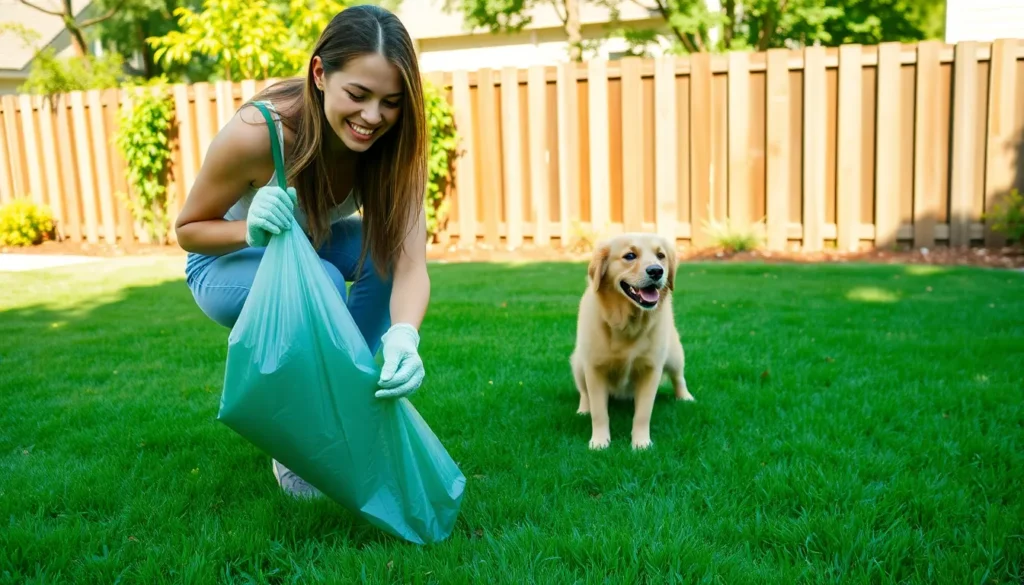Imagine a world where your furry friend can communicate their needs without the usual barking or scratching at the door. Enter pet training bells, the magical solution that turns your pet into a little bell-ringing genius. These bells aren’t just shiny accessories; they’re a game-changer for pet owners seeking a smarter way to understand their pets.
Table of Contents
ToggleOverview of Pet Training Bells
Pet training bells serve as an effective communication tool for pets. Designed to signal a pet’s desire for attention or specific needs, these bells enhance owner-pet interaction. Owners can quickly learn to recognize when their pet wants to go outside, needs food, or seeks companionship.
Models vary in design and sound but function similarly. Training bells often come in sets that pets can easily reach using their paws or noses. Some versions include adjustable features that accommodate different pet sizes and behaviors. Materials used range from durable plastic to metal, ensuring long-lasting use.
Training bells fit seamlessly into a pet’s daily routine. By encouraging pets to indicate their needs, these devices reduce confusion and frustration for both pets and owners. Training a pet to use the bell typically involves placing it near the door and teaching the pet to ring it before going outside.
Timing is crucial during the training phase. Consistently rewarding the pet for using the bell reinforces the desired behavior, creating a positive learning environment. Owners should maintain patience throughout the training process, as every pet learns at its own pace.
Many pet owners report increased satisfaction in their relationship with their pets through the use of training bells. Pets become more communicative, which cultivates a deeper understanding of their needs. Enhanced communication leads to improved overall behavior and a more harmonious household.
Benefits of Using Pet Training Bells

Pet training bells offer numerous advantages for both pets and their owners. These tools enhance communication and promote independence in pets, making them valuable assets in pet care.
Enhancing Communication with Pets
Pet training bells significantly improve communication between pets and their owners. Owners quickly recognize when their pets want to go outside, need food, or seek companionship. This clarity eliminates frustration for both parties, as pets can express needs directly. Many pet owners report faster responses to their pets’ requests, creating a more responsive environment. Increased understanding leads to fewer accidents indoors and strengthens the pet-owner bond. The bells come in varied sounds and designs, catering to different pet preferences, yet all serve the same purpose of effective communication.
Promoting Independence
Using training bells fosters a sense of independence in pets. Pets learn to indicate their needs without relying on constant supervision, granting them a level of self-sufficiency. Empowerment comes from their ability to signal when they want to go outside or need attention. In turn, this reduces anxiety and allows pets to feel more in control of their environment. Greater independence also encourages pets to engage more with their surroundings, leading to happier and healthier behavior. Training bells become a tool not just for communication but for enhancing overall well-being in pets.
Types of Pet Training Bells
Pet training bells come in several types, each designed to suit different preferences and needs. These variations enhance communication between pets and their owners.
Acoustic Bells
Acoustic bells produce clear sounds when pets interact with them. These bells typically have a traditional design, featuring a simple mechanism that pets can easily ring. Most commonly, owners place these bells near doors to signal when pets want to go outside. Many animals recognize the distinct sound, which reinforces the connection between ringing the bell and their desired actions. High-quality acoustic bells come in various colors and sizes, making it easy to find one that fits the home aesthetic. For those looking for an organic training experience, acoustic bells provide an effective option.
Electronic Bells
Electronic bells utilize sound and light to offer a modern twist on training. These devices often incorporate sensors that trigger sounds or lights when activated by a pet. Many electronic bells come with adjustable volume levels, catering to different pet sensitivities. Owners appreciate these bells for their versatility; they can be placed indoors or outdoors without concern for weather damage. Battery-operated models ensure longevity, while some include features like pre-recorded messages. Electronic bells provide a contemporary alternative for enhancing communication with pets, making training engaging and effective.
How to Train Your Pet with Training Bells
Training pets with bells requires focus and consistency. This approach fosters effective communication, enhancing the relationship between pets and their owners.
Step-by-Step Training Process
Start by placing the bell near the door where your pet typically exits. Encourage your pet to interact with the bell by using a treat or favorite toy. When the pet touches or rings the bell, immediately provide positive reinforcement, such as praise or a reward. Repeat this process several times a day to establish the behavior. Gradually introduce the command to ring the bell before going outside. After a few successful repetitions, your pet will learn to associate ringing the bell with outdoor time.
Tips for Success
Use short training sessions to maintain your pet’s attention and enthusiasm. Be patient and allow time for your pet to learn the process, as each pet will grasp the concept at its own pace. Reward the pet consistently for ringing the bell to reinforce learning. Keep the bell easily accessible, ensuring it remains a part of the daily routine. Monitor progress and celebrate small victories to maintain motivation.
Common Mistakes to Avoid
Training pets with bells presents challenges that can hinder progress. One mistake often made involves inconsistency in training sessions. Pets thrive on routine, so maintaining a schedule helps reinforce behavior.
Another common error includes neglecting to reward immediate responses. Positive reinforcement should occur as soon as the pet interacts with the bell. Delaying rewards can confuse pets, leading to misunderstandings.
Failing to use the bells correctly can inhibit effective communication. Owners must always place the bells near the door, ensuring pets associate the sound with going outside. Distractions during training can sidetrack the pet’s understanding of the bell’s purpose.
Overtraining can also be an issue. Limiting training sessions to 5-10 minutes keeps pets engaged and prevents frustration. Ending each session on a positive note helps build confidence.
Skipping gradual introductions of the bell is a mistake many make. Incorporating the bell into playtime or using treats can encourage pets to explore its function. Giving pets time to adjust to the sound of the bell is essential.
Lastly, ignoring the pet’s progress can undermine confidence. Observing small victories reinforces positive behavior and strengthens the bond. Documenting progress can help owners identify what works best, allowing for adjustments to training methods.
Avoiding these common mistakes fosters a smoother training experience. Consistency, immediate reinforcement, proper usage, brief sessions, gradual introduction, and recognizing progress all contribute to successful communication with pets using bells.
Pet training bells offer a unique way for pets to communicate their needs effectively. By using these bells, pet owners can strengthen their bond with their furry companions while promoting independence and reducing frustration. The training process may require patience and consistency but the rewards are well worth the effort.
With various types of bells available, from acoustic to electronic, there’s an option to suit every pet’s personality and home environment. As pets learn to express their desires through ringing the bells, owners can enjoy a more harmonious household and a deeper understanding of their pets’ needs. Embracing this innovative tool can lead to happier pets and more satisfying relationships.








